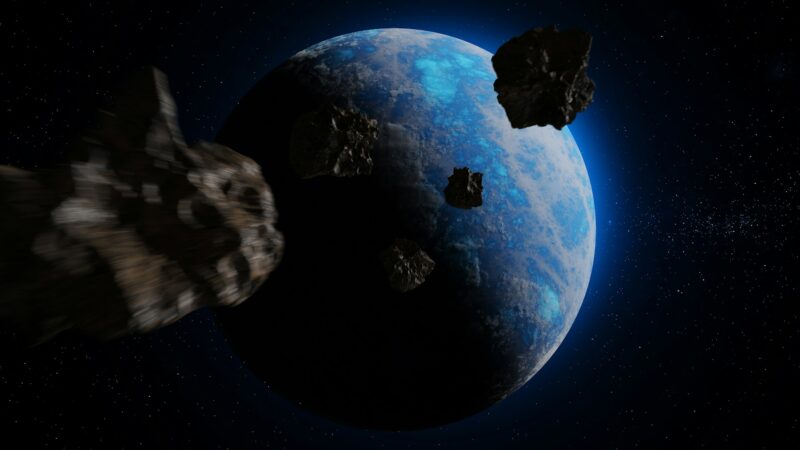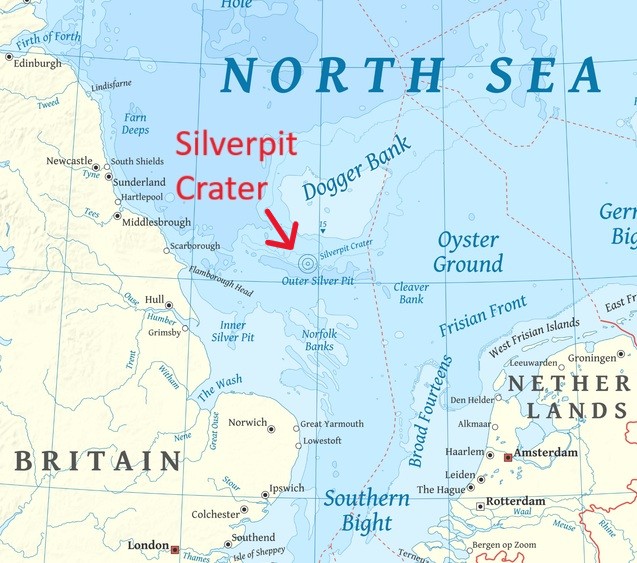Now Reading: Evidence of an ancient asteroid impact in the North Sea
-
01
Evidence of an ancient asteroid impact in the North Sea
Evidence of an ancient asteroid impact in the North Sea


Evidence for an asteroid impact in the North Sea
Some 43 million years ago, long before humans evolved but long after mammals came upon the scene, an asteroid streaked toward Earth, crashing into what is now the North Sea. That’s according to scientists from Heriot Watt University in Edinburgh, Scotland. They said on September 20, 2025, that an asteroid (or comet) created the Silverpit crater, a depression off the coast of England whose source had been the subject of much debate.
The Silverpit crater is 1.8 miles (3 km) wide, with a 12.5-mile-wide (20-km-wide) ring of circular faults around it. It was first discovered in 2002. Some scientists thought it was an impact crater while others thought it was from volcanic activity. In fact, in 2009, geologists decided to – very unscientifically – put it to a vote. And the majority said its origin was not from an impact. But now, the new evidence begs to differ.
The scientists used seismic imaging, microscopic analysis of rock samples and numerical models to come to their conclusion. The researchers published their peer-reviewed study on September 20, 2025, in the journal Nature Communications.
The Silverpit crater
The Silverpit crater had some easy-to-identify characteristics that suggested it was an impact crater. Notably, the crater has a central peak, circular shape and concentric faults. But in addition, the new evidence reveals rocks that only form under the intense pressure of an impact. Lead author Uisdean Nicholson of Heriot Watt University said:
New seismic imaging has given us an unprecedented look at the crater.
Samples from an oil well in the area also revealed rare ‘shocked’ quartz and feldspar crystals at the same depth as the crater floor.
We were exceptionally lucky to find these, a real ‘needle-in-a-haystack’ effort. These prove the impact crater hypothesis beyond doubt, because they have a fabric that can only be created by extreme shock pressures.

The asteroid impact triggered a massive tsunami
While the continents were drifting and not yet in their current configuration, the scientists said the impact occurred in water. And, what’s more, it resulted in a massive tsunami. Nicholson said:
Our evidence shows that a 160-meter-wide [525-foot-wide] asteroid hit the seabed at a low angle from the west.
Within minutes, it created a 1.5-kilometer [1-mile] high curtain of rock and water that then collapsed into the sea, creating a tsunami over 100 meters [330 feet] high.
Animation of the tsunami resulting from the ancient asteroid impact in the North Sea. Video via Heriot Watt University.
The silver bullet for Silverpit crater
Co-author Gareth Collins from Imperial College London contributed the numerical models for this study. Collins said:
I always thought that the impact hypothesis was the simplest explanation and most consistent with the observations.
It is very rewarding to have finally found the silver bullet. We can now get on with the exciting job of using the amazing new data to learn more about how impacts shape planets below the surface, which is really hard to do on other planets.
Nicholson summed up the results of their study:
Silverpit is a rare and exceptionally preserved hypervelocity impact crater.
These are rare because the Earth is such a dynamic planet; plate tectonics and erosion destroy almost all traces of most of these events.
Around 200 confirmed impact craters exist on land, and only about 33 have been identified beneath the ocean.
We can use these findings to understand how asteroid impacts shaped our planet throughout history, as well as predict what could happen should we have an asteroid collision in future.
Bottom line: New evidence confirms Silverpit crater in the North Sea resulted from an ancient asteroid impact some 43 million years ago.
Source: The silver bullet – new evidence for a hypervelocity impact origin for the Silverpit Crater
The post Evidence of an ancient asteroid impact in the North Sea first appeared on EarthSky.
Stay Informed With the Latest & Most Important News
Previous Post
Next Post
-
 01From Polymerization-Enabled Folding and Assembly to Chemical Evolution: Key Processes for Emergence of Functional Polymers in the Origin of Life
01From Polymerization-Enabled Folding and Assembly to Chemical Evolution: Key Processes for Emergence of Functional Polymers in the Origin of Life -
 02Two Black Holes Observed Circling Each Other for the First Time
02Two Black Holes Observed Circling Each Other for the First Time -
 03How New NASA, India Earth Satellite NISAR Will See Earth
03How New NASA, India Earth Satellite NISAR Will See Earth -
 04Thermodynamic Constraints On The Citric Acid Cycle And Related Reactions In Ocean World Interiors
04Thermodynamic Constraints On The Citric Acid Cycle And Related Reactions In Ocean World Interiors -
 05Φsat-2 begins science phase for AI Earth images
05Φsat-2 begins science phase for AI Earth images -
 06Hurricane forecasters are losing 3 key satellites ahead of peak storm season − a meteorologist explains why it matters
06Hurricane forecasters are losing 3 key satellites ahead of peak storm season − a meteorologist explains why it matters -
 07Binary star systems are complex astronomical objects − a new AI approach could pin down their properties quickly
07Binary star systems are complex astronomical objects − a new AI approach could pin down their properties quickly



















